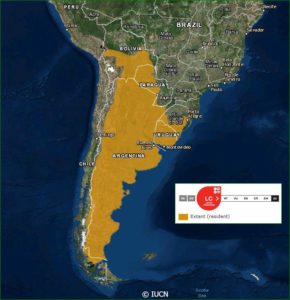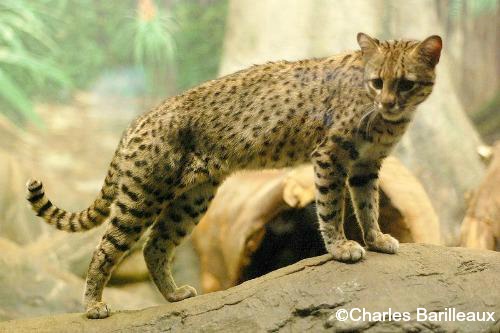- HB Length: 43-88 cm (17-34″)
- Tail Length: 23-40 cm (9-16″)
- Height: 15-25 cm (6-10″)
- Weight: 3-6 kg (6-13 lbs)
- Pop. Trend: Stable
The Geoffroy’s cat Leopardus geoffroyi is one of the most widespread felids in South America. Their coat ranges from brilliant ochre in the northern parts of their range, to a silvery grey in the south, with intermediate shades in between. Numerous small, round, black dots of nearly equal size are placed at equal distances from one another, and form a black ‘necklace’ on the chest. They have several black streaks on the crown and two on each cheek. Underparts are lighter and also marked with solid spots.
The legs are fairly stout, and banded on the upper portion with spots extending down to the toes. The black tipped tail, which is about half of the head-body length, has several black rings. Large, rounded ears are black on the outside and flagged with white central spots. Irises vary from deep golden to a greenish-grey.
In addition to the spotted form, there is also a melanistic variety found more commonly in the forested and wetland areas. Four sub species vary considerably in coat colour and size. The largest cats are from the southern parts of their range, and have a longer, paler coat. As they extend to the north up into Paraguay, they are smaller and darker. Cats from northern Argentina were once considered a separate species because of their indistinct spotting, and called ‘salt desert cats’. In some areas, Geoffroy’s cats can be confused with related species, the Kodkod Leopardus guigna and the Pampas cat Leopardus colocolo.
Distribution

The Geoffroy’s cat occurs in the Andes of southern Bolivia, southern Brazil, Paraguay, Argentina, Uruguay and southern Chile. It has been recorded up to an elevation of 3,800 m in the Bolivian Andes.
In southern Brazil, the northern-most part of their range, the population overlaps with that of the Southern Tiger cat Leopardus guttulus. Both these cats are similar in body proportions and appearance, and researchers have observed hybridization between the two species.
The Geoffroy’s cat is known to disperse over a distance of more than 100 km. Home range sizes in wet pampas grasslands of Argentina averaged 2.5-12 km² with male territories 25% larger than those of females. Home ranges in Torres del Paine National Park in Chile were 7-10 km². The home ranges of females overlap but not those of males and the males have larger home ranges than females.
During a drought period in Argentina, densities ranged from 2-36 cats/100 km², but increased to 139/100 km² two years later. In the Bolivian Chacao, densities were 2-42 cats/100 km².
Habitat
Geoffroy’s cat can occur in a high variety of habitats with preference for areas with dense vegetation. Most of its range is arid or semi-arid. It can be found in pampas grasslands, marsh grasslands, broad-leafed forest, savannas, dry shrublands, arid woodlands, and semi-desert and arid steppe uplands in pristine and disturbed areas. It can even occur in highly-degraded human-developed areas.
As a generalist carnivore and the largest and most adaptable of the small cat species in tropical America, the Ocelot Leopardus pardalis dominates the other small cat species. In areas where the Ocelot occurs, species like the Geoffroy’s cat avoid them because of the threat of predation. This negative effect on other small cat species is called the “ocelot effect”. When Ocelots inhabit protected areas, the smaller cats can be forced into adjacent unprotected areas, where the threat of habitat loss and human interaction is greater.
Ecology
Geoffroy’s cats spend most of their time on the ground, though they climb well and spend some time in trees. Good swimmers, local people call them ‘fishing cats’ and claim that they readily enter water. In Chile, one female was known to have crossed a 30 metre wide fast-flowing river at least 20 times. Generally, however, the local common name is ‘gato de montes’, meaning cat of the mountains.
The Geoffroy’s cat has been described as an opportunistic predator feeding on whatever is most abundant. They hunt mainly on the ground, but may also hunt in water for frogs and fish. In southern Chile, the introduced European hare occurred in more than 50% of all feces examined, and one cat was seen carrying a large hare carcass up into the trees.
A study in Argentina however, found their diet was mainly rodents throughout the year, with birds being well represented in spring and summer. The European hare made less of a contribution to their diet.
The study also found that forest fragments are important for faecal and scent-marking sites, while the grasslands and marshes are used for hunting and resting. Geoffroy’s cats are nocturnal, with activity peaks in the middle of the night. Cats in the study used both natural and highly modified farmland, but preferred patches with high and dense cover.
A comparison study found that, in habitat modified by cattle grazing and ranches, Geoffroy’s cats were more active, travelled greater distances and had larger home ranges than those in protected areas. This behaviour likely indicates a small number of prey species available than in the protected area which has a large portion of natural vegetation. Larger home ranges may also indicate a lower population density of the cats.
Geoffroy’s cats in both study areas showed lower activity levels in winter, during which time hares were found to be an important food item. These animals are much larger than prey consumed throughout the year, thus the cats don’t need to hunt as often.
Cats in the modified area were also active at dawn and dusk, as well as during the night. Resting areas included trees, small patches of tall grass, vizcacha burrows, and a car tire in a garbage pile. During night sightings Geoffroy’s cats were seen rapidly crossing agricultural fields, in semi-natural grassland patches close to a stream, along the railroad and in small patches of introduced trees next to a small lake. Five areas were found where the cats repeatedly deposited feces, all of them associated with trees, in the roots or among large fallen branches.
Geoffroy’s cats occasionally fall prey to pumas. Where the habitat of the two species overlap, the smaller cat will move on to more open landscapes.
Reproduction
Gestation is approximately 72 – 78 days, with one to four young being born Dec-May in a well protected den between rocks, or in dense shrub. Birth weight is 60 – 100 grams. The kittens are weaned in about eight to ten weeks. Females are sexually mature around 18 months and males about 24 months. In comparison with the domestic cat, young Geoffroy’s develop quite slowly. Longevity is up to 18 years.
Threats
- killing by domestic dogs
- killed by vehicle collisions on roads
- retaliation killing for poultry predation
- habitat loss and fragmentation
- shot for meat
- captured illegally and bred with domestic cats to produce hybrid pets
- exposure to domestic carnivore diseases
Conservation
Classed as Least Concern by the IUCN, the Geoffroy`s cat is fully protected across its range. Hunting and trade are prohibited in Argentina, Bolivia, Brazil, Chile, Paraguay and Uruguay.
Although the Geoffroy’s cat is considered to be relatively common, its status is not well known and it is difficult to judge the actual impact of threats. Further research is therefore needed to assess how tolerant and robust the Geoffroy’s cat really is to habitat changes. It is important to protect its habitat, improve anti-poaching activities, and raise awareness about the correct management of domestic cats and dogs.
The Geoffroy’s cat was exploited heavily during the boom of the cat skin trade in the late 1960s to the 1980s. Its coat was the second most common cat fur on the international fur market. Since the 1988s international trade has declined and commercial hunting as it existed in the past seems to have essentially ceased but furs are occasionally found in local markets.
Forested habitat is being rapidly lost over the range of this cat due to deforestation. Recent studies in Argentina however, indicate this species may utilize the resulting open areas.
Read our views on Wild Cat As Pets
Range map IUCN Red List (2018)
Updated 2018


6 Responses